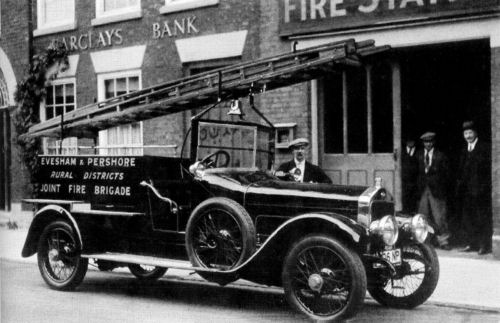| Home . Formation . Equipment . Funding . Local Agreements . Captains . 1897-1933 . Joint Brigade . WW2 . Post War . 1950s . Fires . Gallery | ||||||||||||||||||||||||
|
The
Joint Fire Brigade 1933
|
||||||||||||||||||||||||
|
In
1933 the Broadway brigade became part of a new fire authority which
was set up jointly by the Evesham and the Pershore Rural District Councils.
This new brigade, known as The Evesham & Pershore Rural District
Councils Joint Fire Brigade, was formed following concern about
the poor standard of fire protection in the area.
|
||||||||||||||||||||||||
|
||||||||||||||||||||||||
|
||||||||||||||||||||||||
|
Their
inability to agree was unfortunate, as the modern motorised fire engine
stationed at Evesham, together with the pumps at Broadway, and at
other villages, would have provided reasonable cover, by the standards
of the day, for the whole area. It's understandable, however, that
the Evesham Town councillors would be reluctant to let their expensive
modern machine attend fires in the rural area, only to leave their
ratepayers with reduced fire cover. |
||||||||||||||||||||||||
|
||||||||||||||||||||||||
|
A
trailer pump was purchased for the new Brigade by the Joint Committee,
to be stationed at Pershore fire station. A Wolsey car was offered to
them as a towing vehicle. This offer was accepted, and the vehicle was
suitably converted. On 11th May 1933, the new trailer pump was successfully
demonstrated at Cropthorne in front of a large group of spectators.
Five days later Pershore's steamer was got to work on the Weir Meadow,
under the captaincy of Ben Hitchcock, for the benefit of the District
councillors. The nominal output of the steamer at 380 gallons of water
per minute was greater than that of the new trailer pump but the new
pump was lighter and more versatile.
|
||||||||||||||||||||||||
|
The
Broadway fire brigade with it's manual engine, while still belonging
to the parish, was now under the financial and operational control of
The Evesham and Pershore Rural Districts Joint Fire Brigade Committee.
This remained the situation until 1941 when, as described in a later
section, all fire brigades in the country became part of the National
Fire Service. Despite their earlier disagreements, both the Evesham
Town Council and the Rural District Council were soon able to report
that they had assisted each other at a fires in each other's areas.
|
||||||||||||||||||||||||
|
||||||||||||||||||||||||
|
By
1939, when Titchmarsh & Hunt's premises, in Childswickham Road,
were destroyed by fire, virtually nothing, with regard to the Broadway
brigade, had changed since its formation in 1897. The Merryweather manual
fire engine was, by this time, forty-two years old, and in a poor state
of repair. Following the fire there was, as there had been in 1934,
a public outcry, about the poor fire fighting facilities provided for
the village. The Parish Council wrote to the Joint Fire Brigade Committee
expressing their concern, and suggested that the Merryweather engine
should either be scrapped or put in a museum. The Committee wrote back
to the Parish Council on 26th June 1939 informing them that a large
Gwynne trailer pump had already been ordered for the Broadway brigade.
It was being provided on the understanding that it would be used to
cover the villages on the east side of Evesham as well as Broadway itself.
Also, the committee said it intended to meet Charles Steward, the captain
of the brigade, to discuss the question of towing the pump. They hoped
that his lorry would be used for hauling the new pump as it had been
for the Merryweather.
|
||||||||||||||||||||||||
|
So
ended the era of the manual pump, not only in Broadway but throughout
the country. Broadway's manual fire engine, still in use during the
summer of 1939, was one of the last to see active service anywhere. |
||||||||||||||||||||||||
|
|
||||||||||||||||||||||||


